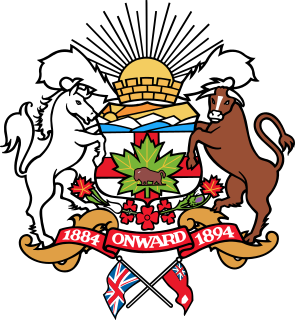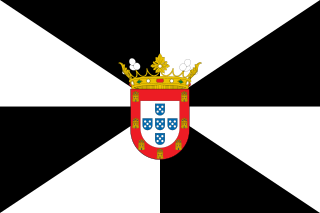
A coat of arms is a heraldic visual design on an escutcheon, surcoat, or tabard. The coat of arms on an escutcheon forms the central element of the full heraldic achievement, which in its whole consists of a shield, supporters, a crest, and a motto. A coat of arms is traditionally unique to an individual person, family, state, organization, school or corporation.

A saltire, also called Saint Andrew's Cross or the crux decussata, is a heraldic symbol in the form of a diagonal cross, like the shape of the letter X in Roman type. The word comes from the Middle French sautoir, Medieval Latin saltatoria ("stirrup").

The flag of Switzerland displays a white cross in the centre of a square red field. The white cross is known as the Swiss cross. Its arms are equilateral, and their ratio of length to width is 7:6. The size of the cross in relation to the field was set in 2017 as 5:8.

Each of the 26 modern cantons of Switzerland has an official flag and a coat of arms. The history of development of these designs spans the 13th to the 20th centuries.

The first coat of arms of Montreal was designed by Jacques Viger, the first mayor of Montreal, and adopted in 1833 by the city councillors. Modifications were made some one hundred five years later and adopted on 21 March 1938, and again on 13 September 2017, resulting in the version currently in use. The coat of arms was the only city emblem representing Montreal until 1981, when a stylized logo was developed for common daily use, reserving the coat of arms for ceremonial occasions.

The coat of arms of Gibraltar was first granted by a Royal Warrant passed in Toledo on 10 July 1502 by Isabella I of Castile during Gibraltar's Spanish period. The arms consists of an escutcheon and features a three-towered red castle under which hangs a golden key.

Portuguese heraldry encompasses the modern and historic traditions of heraldry in Portugal and the Portuguese Empire. Portuguese heraldry is part of the larger Iberian tradition of heraldry, one of the major schools of heraldic tradition, and grants coats of arms to individuals, cities, Portuguese colonies, and other institutions. Heraldry has been practiced in Portugal at least since the 11th century, however it only became standardized and popularized in the 16th century, during the reign of King Manuel I of Portugal, who created the first heraldic ordinances in the country. Like in other Iberian heraldic traditions, the use of quartering and augmentations of honor is highly representative of Portuguese heraldry, but unlike in any other Iberian traditions, the use of heraldic crests is highly popular.

The coat of arms of Calgary, Alberta, was adopted in 1902. The arms existed only in black and white until 1984, when an alderman asked the city to develop it in full colour.

The flag of Ceuta is the flag of the Spanish city of Ceuta, consisting of a black and white gyronny with a central escutcheon displaying the municipal coat of arms. The civil flag omits the escutcheon.

The flag of Vancouver, British Columbia, Canada, was adopted by City Council on May 17, 1983. It was designed by Robert Watt, the director of the Vancouver Museum at the time, and later the Chief Herald of Canada. It features a white field with five wavy blue barrulets, and a green pentagon on the hoist side surmounted by a gold shield with the city badge, which consists of a mural crown with crossed axe and paddle.

The municipal flag of Buffalo is the official banner of the city of Buffalo, New York. The navy blue flag contains a large central emblem consisting of the city seal with 13 "electric flashes" and interspaced 5-pointed white stars emanating from it.

The coat of arms of the German state and city of Hamburg is a kind of national emblem. The coat of arms and the flags are regulated by the constitution of Hamburg and law. The colors of Hamburg are white and red. One of the oldest versions of the castle is found on a seal in 1241.

The municipality of Trabazos is located in the west of the Zamora Province, on the border with Portugal, 75 km from the provincial capital. The municipality is made of the five villages of Latedo, Nuez de Aliste, San Martín del Pedroso, Trabazos and Villarino Tras la Sierra.

The Flag of Lisbon, also known as the Flag of Saint Vincent, is the municipal flag of Lisbon, consisting of a gyronny alternating between black and white defaced with the coat of arms of Lisbon in the center. For civil use the flag is flown without the coat of arms.

The flag of Mexico is a vertical tricolor of green, white, and red with the national coat of arms charged in the center of the white stripe. While the meaning of the colors has changed over time, these three colors were adopted by Mexico following independence from Spain during the country's War of Independence, and subsequent First Mexican Empire. The form of the coat of arms was most recently revised in 1968, but the overall design has been used since 1821, when the First National Flag was created.

The flag of Berlin has three stripes of red-white-red, the two outer stripes each occupying a fifth of its height, the middle the remaining three fifths. It is emblazoned with a bear on the civil flag, while it bears the coat of arms of Berlin on the state flag.

The current flag of the state of Sabah, in Malaysia, was adopted on 16 September 1988. It is red, white and three different shades of blue. The mountain is in the canton as in the 1963 flag, but now in dark blue on a light blue background. The field is medium blue over white over red. The mountain shown on the flag is Mount Kinabalu.

The Municipality of Kočevje is a municipality in southern Slovenia. The seat of the municipality is the city of Kočevje. Today it is part of the Southeast Slovenia Statistical Region. In terms of area, it is the largest municipality in Slovenia.

The current flag of Weert was determined on 26 June 1980 as the municipal flag of the Limburgian municipality of Weert in the Netherlands. It replaced a previously determined flag from 1962. On 1 September 1980 the current flag was hoised for the first time during the official opening of the new municipal building at that time.



















